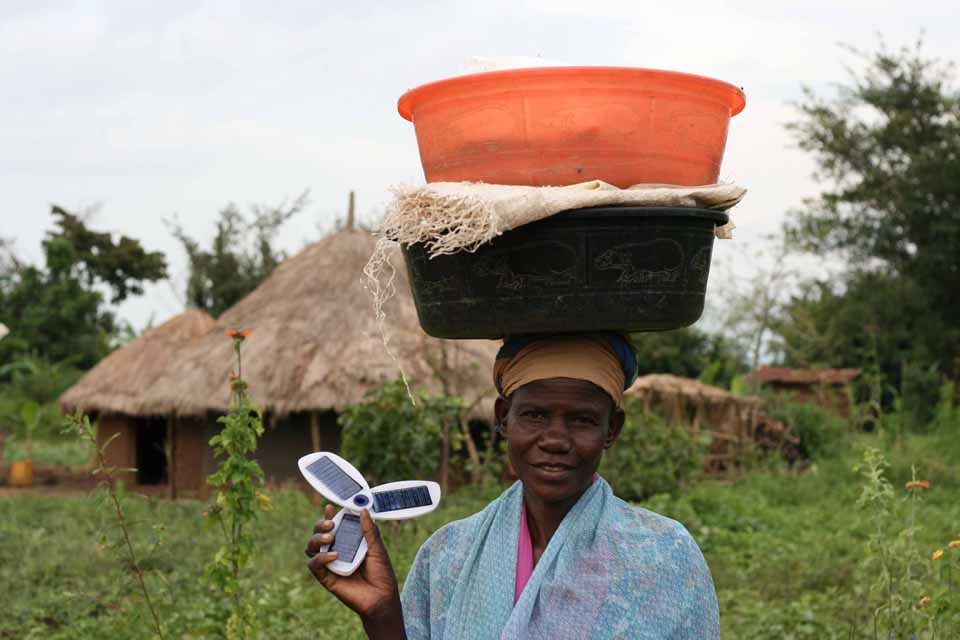
Solio is a solar panel producer distributing in Uganda. One of the main challenges with this technology is that it is expensive. Photo: Solio/ Creative Commons
Swizeen Ndyabawe
Uganda is among the countries in Africa with the lowest electricity access rates. According to the Bureau of Statistics access to electricity by Ugandans is at 14 %. 40 % of urban households have access to electricity, while only 5% of rural households have access to electricity.

Swizeen Ndyabawe is a grad student at the Center for human rights at the University of Oslo and is currently interning at the Fivas office, photo: Jonas Holmqvist
Uganda also has the lowest electricity consumption per capita in the world. Consumption of electricity is partly affected by high tariff; Uganda has one of the highest electricity tariffs in the world. High tariffs, especially commercial and industrial tariffs, negatively affect production, thus cheap electricity for commercial and industrial enterprises is needed to boost production and employment. An example of where this is needed is in the agro processing industries since Uganda heavily depends on agriculture.
Another constraint to accessing electricity is the inability of the rural population to afford connection costs. This negatively affects a big percentage of the population especially those who live close to the distribution lines. The desired target of becoming an upper middle income economy cannot be achieved without the majority of the population being connected to reliable and affordable electricity.
High population growth
The demand for electricity is higher than the supply, especially in the urban areas. This inadequate electricity supply has been exacerbated by a rapidly growing population; Uganda has one of the highest population growth rates in the world. Therefore high electricity tariffs, connection costs and power shortage are the major problems affecting the energy sector in Uganda today.
The slow progress in ensuring that majority of Ugandans have access to electricity is partly due to the limited exploitation of renewable sources that can offer alternative sources of clean and cheap energy. The government of Uganda has continued to ignore its own policies and legal requirements to diversify energy sources and provide its people with clean, reliable and affordable power.
Current efforts of improving electricity generation and access have largely focused on the exploitation of water sources. The government’s efforts are now focused on a few large and many small hydro plants. However, the increasing changes in climate, for example prolonged drought, which has caused reduction in water sources pose severe challenges for hydro electricity generation. It is therefore important that Uganda quickly moves to investment in alternative non-hydro sources of electricity. Uganda produces about 870 megawatts largely from hydro power resources, but its potential capacity is projected at 3,000 megawatts if other power sources are utilized.
Fast-tracking of projects
According to Uganda Vision 2040 master plan, Uganda needs to generate 42,000MW of electricity from hydro, petroleum and gas sources, geo-thermal and nuclear sources, using uranium to become an upper middle income country. Uganda recently embarked on a donor funded project, the Global Energy Transfer for Feed-in-Tarrifs (GET-FiT) programme which aims at fast-tracking about 20 small renewable projects. These include the 1MW power plant in the district of Gulu which will be the first biomass gasification plant in Uganda utilizing ground nut husks and Kakira sugar and allied industries power plants which will run on bagasse, a sugar cane by-product.
According to the Uganda National Development Plan 2010/2011-2014/2015, the demand for electricity is estimated to be growing at between 10 –12% per annum Uganda. Renewable energy other than hydro sources only account for 12% of total electricity generation.
In this financial year 2014/2015, Uganda has spent a lot of money in fast tracking the construction of Karuma and Isimba hydro power plants, as the country steps up efforts to increase power supply and redeem its power sector. However, reliance on hydro power, which provides almost 88% of the country’s 870MW installed grid capacity has plunged Uganda into years of chronic power shortages, load shedding and low levels of power penetration, especially in the rural areas. This shows that Uganda cannot keep pace with its energy demands by relying on a single power source. It’s thus clear that an expanded and diversified range of renewable power sources is critical in solving the electricity problems in Uganda.
The energy poverty in Uganda most especially at household level has also threatened conservation, social-economic development of Uganda’s economy. Ugandan has the capacity to utilize the abundant energy resources, particularly solar, wind, geothermal, and biogas. It is only through utilization of these energy sources that Uganda can achieve its target of having universal electrification by 2035.
Using waste to produce electricity
Every household in Uganda has got wastes or manure that can be used to produce electricity. More so, there is a lot of garbage and waste around the city. This garbage and manure which is readily available can produce biogas energy which is cheap, sustainable and efficient compared to hydro power. It is pro-poor because it requires low levels of technology and can be used in remote areas where hydro power through national grid has failed to reach and serve. Solid waste generated at domestic level is the largest component of all wastes in the country.
Another source of bio gas energy that Uganda can take advantage of is the use of maize cob waste which has proven successful in providing off-grid electricity in some parts of rural Uganda. Uganda can learn from other highly populated countries like China and India, where thousands of people have benefited from the successful turning of waste into electricity.
The growing oil sector after the discovery of oil in the western part of the country also offers another opportunity for the exploitation of natural gas. This produces less emission than burning of firewood which characterizes most rural households since they cannot afford the price of hydro-power generated electricity.
Wind as a source of power
According to Uganda’s renewable energy policy, wind data collected by the country’s meteorology department concluded that wind energy is available and sufficient for power generation. This goes especially for the south western districts of Kabale, Ntungamo, Kisoro and around Mt Elgon. These areas have the average wind speed enough to produce wind energy, which means that wind energy potential can be harnessed as an alternative source of cheap power and for diversification of Uganda’s power sector.
Uganda Veterans Wind Power Initiative has taken steps in delivering cheap power to some Ugandans, especially in rural areas without access to hydro power. For example in the Koome islands and the Mukono district local materials, especially wood and iron sheets, have been used to produce energy under a pilot wind energy project. Uganda can also learn from her neighbour Kenya which has produced 5.45MW from wind energy and the ongoing construction of a 380 turbine wind farm in the northern district of Turkana will double Kenya’s national power supply. Wind energy can go a long way in fulfilling Article 39 of Uganda’s 1995 Constitution which gives citizens the right to a clean and healthy environment. Wind turbines don’t produce atmospheric emissions that cause greenhouse gasses responsible for global warming effect.
Solar a costy alternative
The government should reduce the import tax levied on solar appliances to reduce the prices of appliances to increase access to solar energy. Appliances like solar panels are imported at a high price and taxed highly thus making them expensive despite providing a viable alternative for communities that are far away from the national grid.
According to Carol Namagembe, a programme officer at the Uganda Civil Society Budget Advocacy Group, only 3 billion of the 28 billion Ugandan shillings for renewable energy in the 2014/2015 budget is from the government. The rest is from donors. This shows that the current funding for renewable energy may not sustain Uganda’s move towards renewable energy as an alternative to hydro power.
The government of Uganda should therefore exploit the available alternative clean, cheap and affordable energy sources to increase electricity generation capacity and utilization of clean energy sources. Particularly solar, wind, geothermal, and biomass gasification. This will not only diversify sources of electricity supply but also ensure that majority of Ugandans have access to electricity. This can be complmented by national grid extensions.

